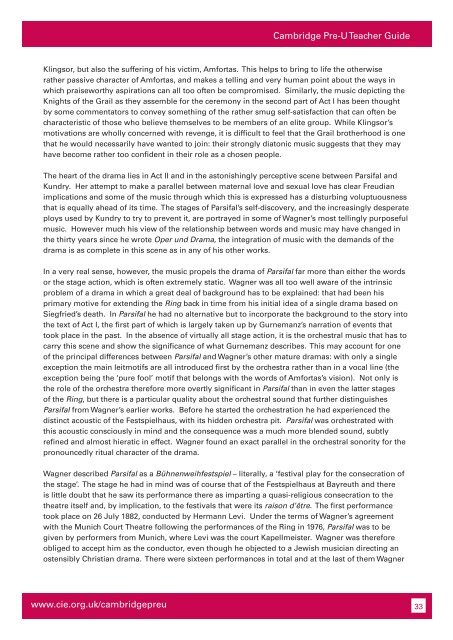Teacher's Guide Cambridge Pre-U MUSIC Available for teaching ...
Teacher's Guide Cambridge Pre-U MUSIC Available for teaching ...
Teacher's Guide Cambridge Pre-U MUSIC Available for teaching ...
You also want an ePaper? Increase the reach of your titles
YUMPU automatically turns print PDFs into web optimized ePapers that Google loves.
<strong>Cambridge</strong> <strong>Pre</strong>-U Teacher <strong>Guide</strong><br />
Klingsor, but also the suffering of his victim, Am<strong>for</strong>tas. This helps to bring to life the otherwise<br />
rather passive character of Am<strong>for</strong>tas, and makes a telling and very human point about the ways in<br />
which praiseworthy aspirations can all too often be compromised. Similarly, the music depicting the<br />
Knights of the Grail as they assemble <strong>for</strong> the ceremony in the second part of Act I has been thought<br />
by some commentators to convey something of the rather smug self-satisfaction that can often be<br />
characteristic of those who believe themselves to be members of an elite group. While Klingsor’s<br />
motivations are wholly concerned with revenge, it is difficult to feel that the Grail brotherhood is one<br />
that he would necessarily have wanted to join: their strongly diatonic music suggests that they may<br />
have become rather too confident in their role as a chosen people.<br />
The heart of the drama lies in Act II and in the astonishingly perceptive scene between Parsifal and<br />
Kundry. Her attempt to make a parallel between maternal love and sexual love has clear Freudian<br />
implications and some of the music through which this is expressed has a disturbing voluptuousness<br />
that is equally ahead of its time. The stages of Parsifal’s self-discovery, and the increasingly desperate<br />
ploys used by Kundry to try to prevent it, are portrayed in some of Wagner’s most tellingly purposeful<br />
music. However much his view of the relationship between words and music may have changed in<br />
the thirty years since he wrote Oper und Drama, the integration of music with the demands of the<br />
drama is as complete in this scene as in any of his other works.<br />
In a very real sense, however, the music propels the drama of Parsifal far more than either the words<br />
or the stage action, which is often extremely static. Wagner was all too well aware of the intrinsic<br />
problem of a drama in which a great deal of background has to be explained: that had been his<br />
primary motive <strong>for</strong> extending the Ring back in time from his initial idea of a single drama based on<br />
Siegfried’s death. In Parsifal he had no alternative but to incorporate the background to the story into<br />
the text of Act I, the first part of which is largely taken up by Gurnemanz’s narration of events that<br />
took place in the past. In the absence of virtually all stage action, it is the orchestral music that has to<br />
carry this scene and show the significance of what Gurnemanz describes. This may account <strong>for</strong> one<br />
of the principal differences between Parsifal and Wagner’s other mature dramas: with only a single<br />
exception the main leitmotifs are all introduced first by the orchestra rather than in a vocal line (the<br />
exception being the ‘pure fool’ motif that belongs with the words of Am<strong>for</strong>tas’s vision). Not only is<br />
the role of the orchestra there<strong>for</strong>e more overtly significant in Parsifal than in even the latter stages<br />
of the Ring, but there is a particular quality about the orchestral sound that further distinguishes<br />
Parsifal from Wagner’s earlier works. Be<strong>for</strong>e he started the orchestration he had experienced the<br />
distinct acoustic of the Festspielhaus, with its hidden orchestra pit. Parsifal was orchestrated with<br />
this acoustic consciously in mind and the consequence was a much more blended sound, subtly<br />
refined and almost hieratic in effect. Wagner found an exact parallel in the orchestral sonority <strong>for</strong> the<br />
pronouncedly ritual character of the drama.<br />
Wagner described Parsifal as a Bühnenweihfestspiel – literally, a ‘festival play <strong>for</strong> the consecration of<br />
the stage’. The stage he had in mind was of course that of the Festspielhaus at Bayreuth and there<br />
is little doubt that he saw its per<strong>for</strong>mance there as imparting a quasi-religious consecration to the<br />
theatre itself and, by implication, to the festivals that were its raison d’être. The first per<strong>for</strong>mance<br />
took place on 26 July 1882, conducted by Hermann Levi. Under the terms of Wagner’s agreement<br />
with the Munich Court Theatre following the per<strong>for</strong>mances of the Ring in 1976, Parsifal was to be<br />
given by per<strong>for</strong>mers from Munich, where Levi was the court Kapellmeister. Wagner was there<strong>for</strong>e<br />
obliged to accept him as the conductor, even though he objected to a Jewish musician directing an<br />
ostensibly Christian drama. There were sixteen per<strong>for</strong>mances in total and at the last of them Wagner<br />
www.cie.org.uk/cambridgepreu 33
















